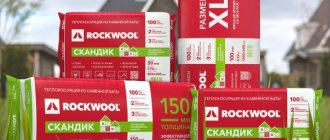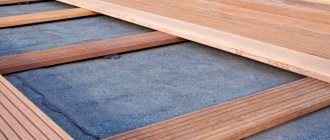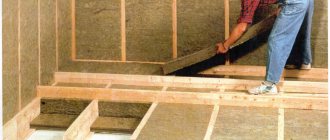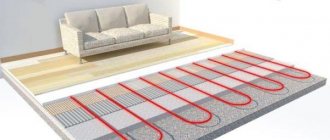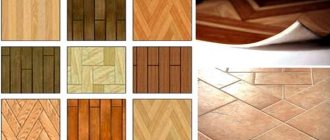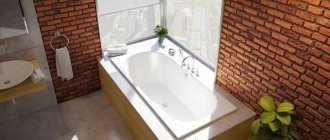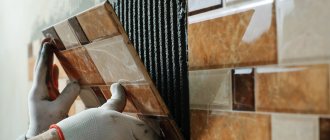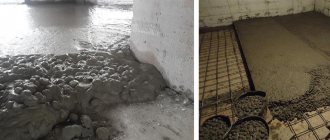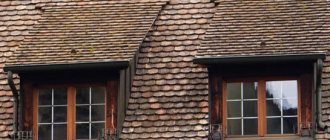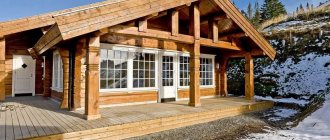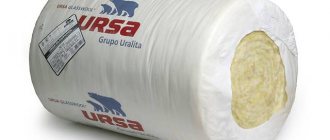Roof insulation - advanced technologies:
- Expanded polystyrene
- Penoplex
- Minvata
- Polyurethane foam
- Penoizol
- Ecowool
- Sawdust
- Expanded clay
How to insulate different types of roofs:
- Mansard roof
- Cold roof
- Attic
- Flat roof
- Garage
Cost of roof insulation
Insulation of the roof of an enterprise
Air heated in a room is known to rise.
If the roof is not insulated, the heat leaves the house and goes outside.
Therefore, roof insulation is one of the most effective heat-saving measures.
Currently, there are many materials and methods of thermal insulation of roofs.
We invite you to further familiarize yourself with the most advanced and effective technologies.
Insulating the roof of a building - basic methods and materials
The concept of “ roof insulation ” means the creation of a thermal insulation layer that prevents heat from escaping outside, that is, keeps it indoors.
For these purposes, materials with low thermal conductivity are used.
As a rule, they have a cellular or fibrous structure and low density.
As a result, most of their volume is occupied by air, which is one of the best heat insulators.
The exception is polyurethane foam, which we will discuss in more detail below.
All options for insulating roofs of buildings can be divided into two types:
- internal - the most common method, which is most often used for thermal insulation of pitched roofs, but can also be used for flat structures;
- external - used exclusively for flat roofs or pitched roofs during their construction or reconstruction.
All insulation materials are divided into three main types:
- polymer - these include regular, liquid and extruded polystyrene foam, as well as polyurethane foam. All these materials have a cellular structure;
- mineral - their most common types are stone wool, glass wool, expanded clay, etc.;
- organic – these include ecowool, sawdust, flax insulation and more.
To make the right choice, consider factors such as:
- thickness and thermal conductivity - selected taking into account climatic conditions in the region;
- service life - modern materials can effectively protect the roof from the cold for decades;
- performance qualities - these include moisture resistance, fire safety, and environmental friendliness.
Video description
The video shows how a flat roof of a building is covered with polyurethane foam:
How to insulate a pitched roof
Thermal insulation of a pitched roof is the installation of insulation between the rafters. With a caveat - if a slab model is used for this. If polyurethane foam is used, then the entire rafter system is filled, including the rafters themselves.
We will not go into the details of creating a warm roof using polystyrene foam boards and mineral wool. Let's just designate what layers it consists of.
If you decide to use mineral wool slabs:
- The first layer is closer to the roofing - vapor barrier .
- The second is insulation .
- The third is a waterproofing membrane .
The bottom waterproofing layer is protective. Its task is to prevent moist warm air vapors emanating from the interior of the house from penetrating the thermal insulation layer. As mentioned above, mineral wool is a hygroscopic material, it absorbs moisture well, losing its thermal insulation qualities.
Layers of materials in the arrangement of a warm roof Source stroyfora.ru
Roof insulation with foam plastic (expanded polystyrene)
Polystyrene foam, also known as expanded polystyrene, is a white cellular polymer heat insulator.
It is well known to everyone as a packaging material for fragile products.
Foam insulation is sold in the form of rectangular slabs, which come in various thicknesses.
One of the main differences between this material is its density, which is in the range of 15-50 kg/m3.
In pitched roofs, foam plastic is not subject to any mechanical stress, so it is more advisable to purchase slabs with the lowest density.
Firstly, they are cheaper, and secondly, the lower the density, the lower the thermal conductivity coefficient:
- PSB S15 – 0.037 W/(m K);
- PSB S25 – 0.035 W/(m K);
- PSB S35 – 0.033 W/(m K).
If the roof is flat and the insulation is planned to be done from the outside, you will need a grade no lower than PSB S25-PSB S35.
One of the most important advantages of expanded polystyrene is that even high-density grades have a low thermal conductivity coefficient.
In addition, expanded polystyrene has a number of other advantages:
- light weight;
- affordable price;
- easy to machine;
- not subject to rotting.
However, polystyrene foam also has several serious disadvantages:
- most often burns well - many manufacturers, in order to reduce the cost of their products, save on fire retardants, as a result of which the material ignites from a lit match;
- toxicity – the polystyrene foam itself is safe, but when subjected to strong heating and melting, for example during a fire, it releases toxic substances;
- absorbs moisture - as a result, the thermal insulation properties are reduced, so the insulation needs high-quality vapor barrier.
Do-it-yourself roof insulation (step by step)
- The insulation is installed after installing the hydro-windproof membrane. It is mounted from below, from the attic side, between the rafters and from the bottom up. With multi-layer insulation, all layers of thermal insulation material are laid with the seams staggered. If the thickness of the required layer of thermal insulation exceeds the height of the rafters, then they are built up with bars of the required thickness, which are stuffed perpendicularly.
- A vapor barrier film is mounted on the bottom of the rafters. It is attached to the rafters with overlapping horizontal stripes, with the blades overlapping by 100-150 mm, using a construction stapler or nails with a wide head. The joints and places where the film is attached are sealed using vapor barrier tape or reinforced construction tape.
When laying insulation, it is important to ensure that it is installed against the rafters
The disadvantage of using conventional film as a vapor barrier is the numerous tears and punctures during its installation. Even an experienced builder will not notice everything; as a result, the insulation may get wet in places. Therefore, for high-quality vapor barrier, we recommend using specialized membranes, for example, ISOVER Paranet (B).
This is a durable two-layer vapor barrier, which is installed with the smooth side facing the insulation and reliably protects the roofing cake from fumes. The rough inner surface allows you to retain drops of condensation that form in heated rooms in winter.
Roof insulation with extruded polystyrene foam (penoplex)
Popularly, extruded polystyrene foam is often called “Penoplex”.
But this is wrong, since Penoplex is a well-known brand under which this material is produced.
Visually, extruded polystyrene foam is easy to distinguish from regular polystyrene foam.
It is usually painted in bright colors and has a uniform rather than granular structure.
In addition, extruded polystyrene foam has a number of advantages, such as:
- strength and durability;
- thermal conductivity 0.028-0.034 W/(m K);
- does not absorb moisture;
- fire safety - manufacturers add fire retardants to the composition, as a result of which the material does not catch fire or has a self-extinguishing property.
Extruded polystyrene foam
Extruded polystyrene foam also has disadvantages:
- quite high price;
- the material “does not breathe” - this can lead to rotting of the rafters in case of poor-quality vapor barrier or its depressurization;
- toxicity when burning - like polystyrene foam, when heated, it releases toxic substances that can lead to poisoning and death.
Extruded polystyrene foam is excellent for both internal and external roof insulation.
From the outside, it can additionally protect the roof from moisture.
There are special slabs on sale for external insulation that allow for a slight roof slope.
As for internal insulation, as when choosing conventional polystyrene foam, it is advisable to give preference to brands with the lowest density.
Choosing the ideal thermal insulation
When choosing a material, you should pay attention to the following characteristics:
- Life time . The bigger, the better.
- Shape stability . It is necessary that the material does not move or deform during service.
- Specific gravity . The insulation should not weigh too much or too little.
- Frost resistance . After all, the main purpose of insulation is to protect against frost, which means it must endure these frosts calmly.
- Soundproofing . Among other things, the material must not allow sound from a too “noisy” roof to pass through.
- Environmental friendliness . The insulation should not be toxic and safe for you and the environment.
The thickness of the insulation is extremely important . There is no way to miscalculate her. Read below to learn how to correctly calculate the thickness.
Roof insulation with mineral wool
Rock wool, which is made from molten rocks, is currently the most common material for roof insulation.
The material is suitable for these purposes in almost all respects.
Visually it resembles glass wool, but has a higher density.
Most often sold in mat form, but low-density brands can also be found in rolls.
You can touch it with your bare hands with virtually no consequences.
Its fibers are more elastic than glass wool.
Special impregnations make it resistant to moisture - drops of water roll off without penetrating into the mat.
In addition, mineral wool has a number of other advantages:
- environmental friendliness - does not contain harmful substances;
- fire resistance - mats not only do not burn, but are also able to protect a wooden structure from fire;
- high vapor permeability - thanks to this, moisture does not accumulate in the rafters and other wooden parts of the rafter system;
- has an affordable price.
The only disadvantage is that the thermal insulation properties of mineral wool are inferior to polymer materials.
Thermal conductivity is in the range of 0.035 – 0.042 W/(m K).
To compensate for this disadvantage, it is necessary to use a thicker layer of insulation.
In addition, impregnations are not able to fully protect the material from moisture.
Therefore, it is necessary to pay maximum attention to waterproofing.
Errors and recommendations
To achieve maximum insulation efficiency, you need to choose the right material. A common mistake is insufficient insulation width, which leads to the formation of cracks and gaps during installation. It is recommended to use vapor and waterproofing to protect the thermal insulation from moisture.
The absence of such layers leads to excessive moisture in the insulating material, wooden structures begin to rot and deform under the influence of moisture, and metal elements become corroded.
Roof insulation with polyurethane foam
Polyurethane foam is a unique heat insulator that is applied in the form of liquid foam.
By the way, polyurethane foam, known to almost everyone, is polyurethane foam.
True, for insulation it is used in the form of a two-component composition, that is, it is prepared directly during use.
When applied to an insulated surface, the material dries instantly and gains strength.
One of its main features is that it does not absorb moisture at all.
Unlike the materials described above, polyurethane foam does not require the use of a vapor barrier.
Its advantages, of course, are not limited to this.
Additionally, we highlight the following points:
- exceptional thermal conductivity – 0.019 – 0.028 W/(m K);
- provides a continuous thermal insulation layer - thanks to this, cold bridges are eliminated;
- excellent adhesion – sticks to any type of surface;
- high speed of insulation - the roof of a house with an area of 150 square meters can be insulated in a few hours, since fasteners and installation of a vapor barrier are not required;
- fire safety - fire retardants are added to polyurethane foam, which makes it non-flammable.
However, roof insulation with polyurethane foam has a number of disadvantages:
- It is impossible to insulate the roof on your own - this procedure requires sophisticated equipment, as well as extensive work experience and certain knowledge;
- low operator qualifications negatively affect the efficiency and durability of thermal insulation;
- During the polymerization process, polyurethane foam releases toxic substances into the air.
Note that polyurethane foam (PPU) comes in two types:
- closed-cell - the cells of this material are sealed capsules filled with gas, the thermal conductivity of which is even lower than the thermal conductivity of air. Accordingly, this material is the most effective;
- open-cell – has open cells filled with air (spray foam is this type).
Closed cell polyurethane foam has higher performance.
However, it is necessary to take into account that it costs more.
At the same time, gas leaves the cells over time.
As a result, thermal conductivity increases to the level of open-cell polyurethane foam (PPU).
Thermal insulation with foam insulation
Spraying polyurethane foam: achieving quality
This is what you can get as a result of illiterate spraying of polyurethane foam: a pungent smell, the crust on the insulation easily falls under your fingers, and no heat-insulating properties. What is the problem? This is foam that has stratified, and one substance lies in its own layer, and the reagent, which precisely emits a toxic odor, is right under it. This happens when the installation runs out of one of the two substances being connected, but the equipment does not have time to react. A competent team immediately cleans up the area that has failed, and the shabatniks quickly cover it with a new layer to cover it. And repairs will have to be done much later, until the residents of the house inhale isocyanate and someone realizes that the problem is in the insulation of the roof.
In fact, the problem is precisely in the equipment. After all, polyurethane foam is not a finished product that can be purchased in a store and immediately applied to the roof slopes. It is made up of two components, which in the station are combined into one whole substance with completely different properties. But cheap equipment does not allow activating all the components of polyurethane foam, and the resulting insulation cannot be called high-quality. Of course, you won’t be able to determine all this by eye during the insulation process, but the results will not keep you waiting.
As an option, you can insulate the roof with foam insulation, a material similar in properties to polyurethane foam. This is how walls are insulated:
And this is the attic floor:
Roof insulation with liquid foam insulation
Penoizol, also known as liquid foam, like polyurethane foam, is applied in the form of liquid foam.
It then polymerizes within a short time.
Accordingly, penoizol has the same advantages as the polyurethane foam described above - it is quickly applied and forms a continuous layer of thermal insulation.
Another important advantage is its relatively low cost.
Thermal insulation properties are somewhat inferior to polyurethane foam - in the range of 0.033 - 0.048 W/m K.
Insulation with liquid foam insulation
As for the disadvantages of penoizol, there are several of them:
- absorbs moisture - needs vapor barrier . True, thanks to vapor permeability, it is able to remove accumulated moisture out;
- toxic during application - therefore requires the use of protective equipment;
- has low mechanical strength - like polystyrene foam, it is a fragile material;
- It is impossible to insulate the roof on your own - it requires special, sophisticated equipment.
What is the best way to insulate a roof?
We have already answered the question of how to insulate the roof of a private house above. But site visitors want to know how to insulate a log house, garage and bathhouse.
Log house The wooden frame is covered with a pitched roof. Therefore, basalt wool has no competitors.
Garage. Typically, a garage roof is flat. Therefore, expanded clay and basalt wool can be used there at approximately the same cost.
Bathhouse. Anyone who has ever washed in a village bathhouse knows that the roof there is not insulated. Only ceiling insulation can retain steam. You can see how to do it in the work “Rules for choosing insulation for the ceiling.”
Thermal insulation of the roof with cellulose insulation
Cellulose insulation, or ecowool, is made from recycled waste paper.
This explains the low cost of this material.
In addition to cellulose, it contains 20% of various additives that prevent combustion, protect the material from biological influences, increase its moisture resistance, and so on.
Please note that there are two types of ecowool:
- dry – is a bulk material, used for insulating horizontal surfaces or frame walls;
- wet-glue – impregnated with glue, which allows you to spray cotton wool on the surface like foam.
It has excellent adhesion, so it can be used to insulate any surface.
Among the advantages of cellulose insulation are:
- environmental friendliness - it’s not for nothing that the material is called “ecowool”, even during the application process it is completely non-toxic;
- the ability to cover surfaces with a continuous layer - as in the case of foam, there are no cold bridges, it is possible to fill any cavities;
- vapor permeability – ecowool removes moisture well;
- does not burn - when exposed to fire, the insulation only smolders and has the property of self-extinguishing;
- practically does not increase the level of thermal conductivity when moisture accumulates.
If mineral insulation, with the accumulation of several percent of moisture, increases thermal conductivity by 10 times, then ecowool can absorb 25% of moisture . At the same time, increase thermal conductivity by no more than 5%.
Roof insulation with ecowool – disadvantages:
- Thermal conductivity is quite low - 0.032-0.042 W/m·K.
- Over time, it decreases in volume - this leads to an increase in thermal conductivity by 20-30 percent. Therefore, it is necessary to use ecowool with an appropriate reserve.
- It takes a long time to dry - when applied using the wet-adhesive method, drying may take several days.
- It is impossible to carry out insulation yourself - special equipment is required to apply wet-adhesive ecowool.
Thermal insulation with sawdust
Why not just dump the snow?
Note that even today a mechanical method of dealing with ice and icicles is actively used - a shovel, a crowbar and a scraper. It would seem that it would be simpler: knock all this wealth off the roof, and you’re done. No electrical systems, cables or hot water pipes are needed. But in fact, the disadvantages of this method completely cover all its advantages:
- Frozen ice clogs gutters and ruins gutters.
- When cleaning the roof, it is easy to scratch the roof covering, which will quickly lead to corrosion.
- When clearing snow, a person often slides off the roof along with it.
In addition, ice drains themselves are dangerous. They become too heavy and at one moment they can simply collapse on the heads of people standing nearby. And this is not to mention the expensive repairs that can await you.
Convinced? Then let's move on!
Roof insulation with sawdust
Sawdust is the cheapest and most environmentally friendly thermal insulation material.
It has fairly low thermal conductivity.
This indicator is at the level of 0.070–0.093 W/mK.
Sawdust is used to insulate horizontal surfaces, for example, floors.
They simply fall asleep between the beams.
If the floor is concrete, you can use logs on which the flooring will subsequently be laid.
You can also use sawdust to insulate the roof slopes from the outside during its installation.
Insulation with sawdust
To do this, it is necessary to secure a vapor barrier from the inside and make a lining from boards or other material.
Please note that only well-dried sawdust is suitable for insulation.
No traces of rot.
Their main disadvantage is flammability and susceptibility to biological influences.
To eliminate this drawback, you can make a mixture consisting of the following components:
- 85% sawdust;
- 10% lime;
- 5% gypsum paste mixture.
Forgotten insulation materials: ecology is back in fashion!
For many, the issue of ecology today is one of the most important. As studies of individual eco-projects show, in a modern house made of the same modern materials, the air can be so toxic that its harmfulness is almost no different from the toxicity of a busy highway. And almost every modern buyer, armed with the Internet, tries to study the issue of health safety of the construction or repair he has undertaken.
However, the idea is great: read reviews about this or that product, carefully study the composition and the possibility of combination with other materials, and even conduct your own test. And yes, arm yourself with the firm confidence that you need to purchase everything you need for construction only from trusted suppliers!
But, if not for the “but”... The fact is that environmental friendliness is not enough even in expensive foreign insulation materials. With rare exceptions, such as basalt wool. In general, the picture of allergy sufferers (and there are more and more of them lately) is not at all encouraging. Therefore, today the fashion for old, unfairly forgotten “old-fashioned” methods of roof insulation is returning again, and it is the owners of expensive houses and cottages who boast about them.
Expanded clay: an unfairly forgotten technology
Expanded clay is an artificial stone that is obtained from baked clay. It is absolutely not afraid of moisture, is not susceptible to organic matter and does not require any vapor barriers (the main problem of roof insulation has been solved!). And at the same time, it is not flammable.
But this wonderful technology is gradually becoming a thing of the past!
Sawdust: does not burn, does not rot, does not settle
Let’s immediately make a reservation about the flammability of sawdust: only fresh sawdust burns, and you can actually use it to heat a stove in a bathhouse. But rotten ones that have been lying around for a year cannot even be set on fire. This is the type of sawdust that is used to insulate the roof.
It’s surprising, but you can still find old houses with attics insulated with sawdust over clay. Moreover, the sawdust itself, after almost a century, does not even change color! This is why experts conclude that with proper preparation, sawdust can serve as insulation for a very, very long time. And is it worth reminding that such insulation is the most environmentally friendly of all existing ones.
Only modern ecowool, which is made from recycled newspapers, is close to the composition of sawdust, and those at one time were made from cellulose fiber. But here, too, there is a certain percentage of the same printing ink, while sawdust contains no harmful substances at all. In addition, ecowool is additionally treated with boron and other similar substances so that it is not flammable and does not rot.
Reeds, straw and reeds: double benefits
Until recently, roofs were practically not covered with reeds or thatch, even in the most remote hinterlands. The exception is houses specially designed for eco-style or the popular “hobbit house”. But it turns out that the fashion for the old is a profitable business: all over the world it is now becoming increasingly popular to make the roof of a house from reeds and straw. And, as it turned out, this material has a lot of advantages not only as a covering, but also as a roofing insulation. Plus great aesthetic features:
Despite the complexity of harvesting the stems of a reed plant for making a roof, this know-how has many advantages:
- Absolutely environmentally friendly. The stems of the sedge family have a unique structure, which is close in its properties to wood, but at the same time it does not experience the negative influence of the environment. This is partly due to the fact that stems that are about a year old are used for the roof, and during this time the plant simply does not have time to accumulate harmful radicals. Like bamboo, which grows in just 5 years and is recognized as much more environmentally friendly than wood. Of course, an ordinary tree has been growing for decades!
- Purity of the material. In preparation for laying, reed stems are not treated with any chemicals or carcinogens.
- Strength and stability. Because the reed itself grows in swampy areas, but it is not afraid of moisture, sun, or frost. And during its entire service life, the reed is not deformed by precipitation, because it is natural for it.
- Excellent insulation. With such a coating, no insulation is needed at all - the reeds are insulation, two in one.
And the technology for working with such materials is actually not complicated. Here, for example, is how roofs were insulated with straw in ancient times:
And here’s how modern roofs are insulated with straw and wood chips:
As you can see, nothing complicated! Good luck to you in any endeavor!
Roof insulation with expanded clay
Expanded clay is a bulk material made in the form of granules, so its scope is the same as that of saws.
This material is obtained by firing clay with special additives.
During heat treatment it foams.
Due to its porous structure, it has a thermal conductivity of about 0.16 W/mK.
Among the positive qualities of expanded clay are:
- environmental friendliness - there are no toxic substances in the composition;
- vapor permeability – removes accumulated moisture well;
- low cost - is one of the cheapest bulk thermal insulation materials;
- fire resistance – expanded clay does not burn and is able to protect a wooden structure from fire;
- biostability - the material does not rot and is not affected by fungi.
Thermal insulation of the roof with expanded clay
The main disadvantage of expanded clay is its high or relatively high thermal conductivity.
To achieve the desired result, it must be used in a thick layer.
Insulation of gables can be carried out both from the outside and from the inside.
From the outside they are insulated using the same technology as the facade.
For insulation from the inside, a frame is mounted in the form of racks, between which slabs or mats are laid.
Otherwise, the technology is the same as for insulating slopes.
Correct calculation of insulation thickness
The formula for calculating the layer thickness in meters will look like this:
Layer thickness = Thermal resistance of the layer * Thermal conductivity coefficient of the material (roof thermal insulation snip).
These data are provided by the manufacturer and may vary. Specialists at a hardware store will help you find detailed information on each insulation material.
Many experts advise that after receiving the final result, add another half of the calculated value to it. It is worth noting that when using bulk or crushable materials, they should be loosened from time to time so that the current layer thickness is not disturbed and remains stable.
Features of attic roof insulation
The highest demands are placed on the insulation of the attic roof, since it most often serves as a living space.
Therefore, the main characteristics that a thermal insulation material must have are environmental friendliness and fire safety.
Basalt wool has all these qualities.
Less commonly used for these purposes are materials such as:
- polyurethane foam;
- expanded polystyrene;
- ecowool.
As a rule, the thickness of thermal insulation for a residential attic in central Russia is at least 200 mm.
In regions where winter temperatures often exceed -25 degrees, thicker insulation should be used - 250 mm.
The insulation technology depends on the type of material.
Foam materials or ecowool are sprayed in a continuous layer on all surfaces of the structure.
Board materials and mats are used using the following technology:
- Superdiffuse film is used as roofing waterproofing, allowing moisture to escape to the outside;
- the space between the rafter legs is filled with expanded polystyrene. The gaps in the insulation are filled with adhesive foam;
- A vapor barrier film is attached to the side of the room. The joints are taped with double-sided special tape, which allows you to create an absolutely sealed contour;
- wooden slats are mounted on top of the vapor barrier, to which the sheathing is attached.
Not only the comfort in the room, but also the durability of the rafter system depends on compliance with the technology.
How to properly ventilate a roof
- The area of exhaust and supply openings must be determined taking into account certain parameters, which include the volume and concentration of removed vapors, etc., which in practice is not always possible to do. Therefore, they usually use existing empirical findings. 2. The height of the ventilation gap between the base of the roof and the insulation must be at least 5 cm. It directly depends on the length and angle of inclination of the roof slopes. 3. The flow of air is organized both along the entire eaves and in local places - with the help of ventilation grilles that cut into the lining of the eaves overhang. 4. The total area of exhaust ventilation openings installed only at the highest point of the roof must be no less than the area of the supply openings for each slope. Exhaust devices are ventilation hoods for hipped roofs, ventilation ridges, roof aerators, etc. You can use both ready-made (store-bought) devices and those made by yourself. https://www.youtube.com/watch?time_continue=3&v=uzNCsJO2k6w
Insulation of a cold roof
A cold roof is any pitched roof whose slopes are not insulated.
In this case, the space between the slopes and the ceiling itself serves as thermal insulation.
But, since the temperature in the attic is much lower than in a heated house, heat loss is still at a fairly high level.
To avoid them, you should insulate the cold roof, namely, thermal insulation of the ceiling.
Absolutely any material that we mentioned above is suitable for this.
The technology depends on the type of overlap.
If beams serve as the load-bearing element, thermal insulation is carried out as follows:
- the structure is covered with a layer of vapor barrier, which should form a sealed contour;
- then the space between the beams is filled with any heat insulator;
- A layer of waterproofing film and flooring are laid on top of the insulation and beams.
If the floor is a solid slab, insulation can be done either in the manner described above using logs, or by pouring screed.
The principle is quite simple - polystyrene foam slabs are laid on the ceiling.
A concrete screed is poured on top of them.
As a result, the roof remains cold, but at the same time, virtually no heat leaves the room through the ceiling.
Attic insulation
Why insulate the roof
The presence of an attic space is an important factor for the temperature regime of housing, since even an unheated attic, being a buffer between the street and the ceiling of the upper floor, serves as thermal insulation.
On a cold roof, due to heat exchange between the attic and the outside environment, the snow melts - heat loss is evident
* To reduce heat loss through the ceilings of the upper rooms, the floors of the attic rooms are insulated, but heat exchange still occurs through them, and in winter the attic is still a little warmer than outside.
If the roof is not insulated, then in winter condensation forms on its inner surface, which causes rotting of wooden rafters and sheathing, flows down and accumulates on the floor.
Roof without insulation
Attic insulation
Attic insulation involves thermal insulation of slopes, ceilings and gables.
The slopes are insulated from the inside in the same way as an attic roof.
The only thing is that if the procedure is carried out at the stage of roof installation, it can be performed from the outside.
In this case, the insulation technology looks like this:
- on the inside, a vapor barrier and plank sheathing are attached to the rafters;
- on the outside, insulation is placed in the space between the rafters on the filing;
- then the roof is covered with a diffuse film and the roofing material is installed.
The insulation of the floor is carried out according to the scheme described above.
Flat roof insulation
Installation work
When roof insulation was not provided during the construction of a house, then the owners subsequently have to carry out more complex and labor-intensive installation of insulation on the inside of the roof. To do this, you need to prepare the required amount of insulating material, a film or membrane to insulate it from the inside, slats, a stapler, screws and a screwdriver.
Depending on the individual design features, you need to choose one of the methods of laying insulation - on top of the rafters or between them. If in the attic the section of the rafter leg does not protrude inward enough and does not cover the thickness of the insulation, then it must be laid in a continuous layer on top of the protruding wooden structures.
To apply repeated layers of insulation, you will need a sheathing made of profiles or slats, which is attached to the rafters. The design is thicker, but better protects the attic from the cold.
When the width of the rafters allows the insulation to be laid so that the board protrudes outward or is equal to its thickness, then it becomes necessary to seal the gaps that arise in places of contact with the insulation. This can be done using mounting foam, as well as marking the insulation with a margin of 2-3 cm, for dense installation in the niches between the rafters.
When spraying foam insulation, you need to make sure that all surface elements are dried and fill the space between the wooden exits of the structures.
If the slopes have a slight slope, you will need to strengthen the insulation with slatted sheathing or rope mesh so that it does not fall out from its own weight. Before performing complex work, it is better to first watch a video of roof insulation; there are a lot of such videos on the Internet.
Flat roof insulation
A flat roof is usually insulated from the outside.
For these purposes, polymer slab insulation or mineral mats are used.
The technology looks like this:
- a layer of vapor barrier is laid on a well-dried and cleared of debris flat roof;
- Insulation boards are laid on top. As a rule, they are laid in two layers, overlapping the joints, which eliminates cold bridges;
- A waterproofing film is laid on top of the insulation and a screed is poured, which is also waterproofed.
Instead of a screed, a special roofing membrane can be used, which is laid on top of the insulation.
Her seams are sealed.
A flat roof can also be insulated from the inside.
For example, covering it with polyurethane foam, liquid foam or ecowool.
In order not to involve equipment in the work, thermal insulation can also be made using slab materials.
If, for example, the roof is formed of concrete slabs, the insulation technology looks like this:
- expanded polystyrene or mineral wool is glued to the concrete surface with special glue;
- additionally, the insulation is fixed with disc-shaped dowels;
- A reinforced fiberglass mesh is glued to the insulation and covered with a continuous layer of glue, which acts as rough plaster.
If the roof has a rafter structure, it can be insulated in the same way as a gable or attic roof.
Garage roof insulation
Is it possible to insulate a cold roof?
You won’t be able to simply “add up the insulation” of a cold roof in an old house: the covering will have to be completely removed. This is due to two reasons: the need to organize a ventilation gap of sufficient height and to replace the waterproofing film with a vapor-permeable membrane. There is no way to do this from the attic side. True, if the house has “history,” then the roofing usually still needs to be replaced.
If it was built relatively recently, then completely covering the roof means incurring serious costs. Therefore, it is better to make a decision in advance about what will be located above the top floor. It’s even better to play it safe: even if you decide to make a cold roof, you can use a hydro-windproof membrane instead of a film and choose a thicker counterbeam. It is possible to equip the attic even after a few years, the main thing is that it is possible in principle.
Insulation of the attic floor
So, all decisions have been made, materials have been selected, which means you can start working. The main thing to remember: there are no trifles in the roofing business! A properly installed roof will reliably protect the house from cold, heat and bad weather and will serve faithfully for many years.
Garage roof insulation
The process of insulating a garage roof does not differ in any special ways.
It all depends on the type of its design.
If the roof is gable, you can only insulate the ceiling using one of the methods described above.
Thermal insulation of a flat roof can be done both outside and inside according to the standard scheme.
Types of roofing insulation
If you decide to insulate the roof yourself, you need to choose insulation that has low thermal conductivity and is resistant to moisture absorption.
It is important to take into account the fire resistance of such materials, since in this design they are not protected from fire by concrete or metal partitions. Of the types of thermal insulation presented on the modern construction market, several of the most common can be identified:
Roof insulation - price
The cost of roof insulation depends on the type of material chosen.
Below are the prices current for 2018-2019:
- mineral wool – from 100 rub./m2;
- liquid foam - from 2200 rub./m3;
- ecowool - from 160 rub./m2;
- expanded clay - from 1950 rub./m3;
- polyurethane foam - from 400 rub./m3;
- polystyrene foam - from 150 rub./m2.
Consumer Reviews
Review of Linerock “Light effect” insulation:
More details on Otzovik: https://otzovik.com/review_1208058.html
Linerock Light effect
Review of ISOROC mineral wool thermal insulation:
More details on Otzovik: https://otzovik.com/review_7134354.html
mineral wool ISOROC
Another review about ISOROC mineral wool thermal insulation:
More details on Otzovik: https://otzovik.com/review_3951910.html
Review of Penoplex thermal insulation boards:
More details on Otzovik: https://otzovik.com/review_3959072.html
Penoplex slabs
Penoplex slabs
Review of ISOROC mineral wool thermal insulation:More details on Otzovik: https://otzovik.com/review_5193087.html
Manufacturers of thermal insulation materials
The effectiveness of thermal insulation depends not only on compliance with the technology, but also on the quality of the insulation.
When choosing insulation, it is advisable to give preference to products from well-known brands, such as:
Penoplex
Penoplex
Penoplex is a Russian manufacturer that has been producing extruded polystyrene foam since 1998.
Currently it is one of the largest domestic companies.
The products are of high quality, environmental friendliness and durability.
TechnoNIKOL
TechnoNIKOL
TechnoNIKOL is another Russian company that produces high-quality extruded polystyrene foam, mineral wool, hydro-vapor barrier and other insulation materials.
The brand is known not only in Russia, but also far beyond its borders.
In particular, we have our own production sites in Italy, Great Britain, the Czech Republic and many other countries in Europe and the CIS.
Paroc
Paroc
Paroc is one of the largest mineral wool producers in Europe.
The office is located in Finland, but the products are sold in markets of more than 40 countries.
The history of the company goes back more than 80 years.
During this time, the Paroc brand has become synonymous with high quality.
Isover
Isover
Isover is a famous French brand that produces mineral wool known throughout the world.
The Saint-Gobain company, which owns the Parok brand, was founded 350 years ago. Currently, it has representative offices in more than 60 countries around the world.
The products are famous for their high quality and the most modern technologies used in their production.
Knauf
Knauf
Knauf is a German company founded in 1932 that needs no introduction.
It produces a huge amount of building materials.
In particular, thermal insulation materials are also available on the market - polystyrene foam for insulating walls, floors and other surfaces.
Rockwool
Rockwool
Rockwool is an international company headquartered in Denmark.
The company produces stone wool.
The history of Rockwool began in 1909.
Over the 110 years of its existence, it has opened production sites in 28 countries.
Products are supplied to more than 100 countries around the world.
It is very popular in Russia.
The main mistakes when insulating a roof
When installing in a private home, 3 mistakes are most often made:
- Wrong selection of thickness. As a rule, each manufacturer has its own required indicator, and you can find it on the packaging.
- Lack of hydro-vapor barrier.
- Incorrect installation of vapor barrier. It must be laid with the rough side inward and the smooth side outward. Without this, steam will accumulate on the insulation.
Summing up
Experienced builders recommend using slab and roll insulation based on basalt wool to insulate the roof. Provided that hydro- and vapor barrier technology is followed, it can last at least 30 years without reducing its basic performance qualities. The use of polystyrene foam increases the fire hazard level of the structure. And the so-called “ecological” insulation materials are unreasonably expensive and not very effective.
If you liked the article, you learned useful information from it, share your opinion with us and recommend our site to your friends.
